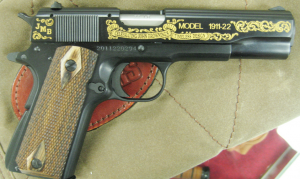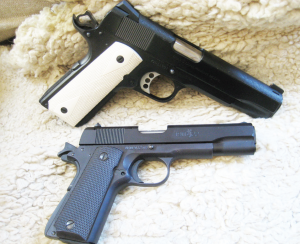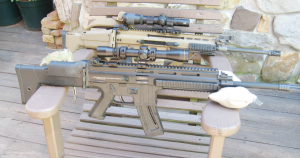by John Markwell
With the increasingly higher cost of centerfire ammunition digging deeper into most folk’s budgets, the good old .22 Long Rifle cartridge has, in recent years, seen more use on the ranges of this great nation than at any time in history. Shooters, both old and new, have been burning up millions (maybe billions?) of rounds each year. Firearms manufacturers, both foreign and domestic, have been catering to the increasing demand for .22 rimfire handguns and rifles with new models tailored to meet the tastes and needs of a diverse shooting public.
We have been working with two of these new introductions: the Browning 1911-22 pistol and the ISSC MK22 Modern Sporting Rifle. Both of these guns are dedicated .22LR versions of two service arms familiar to most TGM readers: the .45ACP 1911 and the .556mm FN SCAR 16S. Both the 1911-22 and the MK22 are magazine-fed semi-autos. They are suitable trainers, or understudy guns, for those who own and/or work with the real deals and are just a boatload of fun on the range.
As everyone knows, 2011 was the 100th year anniversary of the 1911 pistol’s adoption by the US military. It seems every manufacturer of a 1911 pattern pistol brought out a Centennial Model of some sort. From ornately engraved and ivory stocked pistols to period correct reproductions, these commemorative handguns all had one thing in common: they were all full sized 1911s, mostly 45ACPs.
Browning (phone: 801-876-2711; online: browning.com), in contrast to all the other 1911 manufacturers, celebrated the centennial of the 1911 by introducing the diminutive 1911-22. This little rimfire is said to be 7/8 scale but it looks and feels much smaller than that. For those of us accustomed to the full sized 1911, Browning’s 1911-22 pistol seems almost dainty.
Although this pistol is scaled to the .22LR cartridge it is pure 1911 through and through. The frame and slide are aluminum and the action is of the blowback design. The slide has a steel breech face insert. Service style sights grace the slide with the rear being drift adjustable for windage. All safety features of the original Browning 1911 design are present on this pistol as well as a magazine disconnect safety. My pre-production sample did not have the mag disconnect feature and no, it is not available for purchase from the Browning folks. The mainspring housing is of the arched type and the trigger is short with a smooth face. Unlike many .22LR conversion units and other dedicated .22 caliber 1911s, the slide of this little pistol locks back after the last shot is fired. The magazine is of steel and holds 10 rounds.
I took the 1911-22 to an informal Sunday gathering of shooters at the Fort Harmar Rifle Club in Marietta, OH, when I first got it. It was handled, shot a bunch, and drooled over for most of the day. The general consensus was that it was a pretty neat little blaster. Many of the folks with kids, or grandchildren, were extremely interested in the pistol because of its reduced size. Reliability throughout the day’s shooting of a considerable number of rounds (my ammo, of course) was 100%.
Ironically, I had a hard time shooting the little 1911-22 because of the limited flexion in my trigger finger due to arthritis. I can barely shoot a full sized 1911 with a short trigger for the same reason and the reach to the 1911-22’s trigger is shorter than a short triggered full sized 1911. I did however manage to shoot some 25-yard groups from the pistol over sand bags and a few drills on steel with some effort. I ran both Remington and Federal bulk .22LR hollowpoints through the 1911-22 and the pistol functioned perfectly with either load. The 25-yard groups on paper ran between 4 and 5 inches and drills at 10 yards on a steel silhouette proved the 1911-22 to be more that accurate enough for use as an understudy gun to a full sized 1911. I think if the rough 5 pound-plus trigger pull was touched up some, the shootability of the pistol would be greatly enhanced and the practical accuracy would be increased.
If you own A FN SCAR you’ve got to get one of these! The Austrian-made ISSC MK22 Modern Sporting Rifle is imported by Legacy Sports (phone: 775-828-0555; online: legacysports.com) and is just one of the company’s .22 rimfire re-productions of centerfire firearms. The MK22 SCAR clone is a very cool rifle. However, we got off to a rocky start with it. Most folks think the guns sent out for testing/evaluation are hand picked before shipment. Well, not quite! The first MK22 I received would not fire reliably. It went bang maybe 30% of the time when the trigger was pressed; and, yes, I tried different ammo. The folks at Legacy Sports sent a call tag and another rifle quickly. The second SCAR clone ran like a top. As this is written, I have not heard what the problem was with the first rifle.
The ISSC MK22 MSR is a full featured copy of the FN SCAR. Like the SCAR, the receiver of the MK22 is aluminum. The controls on the MK-22 are in the same place as the SCAR although the .22LR clone does not have a bolt release which can be a training consideration. The butt stock is adjustable for comb height and the length of pull is adjustable from 12¼ to about 14 inches. The forearm has rail space galore although the upper rail is not integral with the receiver like the FN rifle. The .22LR magazines, both the 22-round and the politically correct 10-rounder, are the same size as .556 mags which is a good thing if the MK22 is to be used for a trainer.
The MK22 comes with backup iron sights and they offer two options for use. When flipped up, the sight picture is that of the standard aperture sight. The front sight is adjustable for elevation and the rear for windage. In the folded down position, the sight picture is similar to white outline pistol sights. Unfortunately the comb, even in the low position, is too high for me to use the sights in this lower position unless I move my cheek weld back behind the adjustable comb of the stock.
The two-stage trigger on the MK-22 is not bad compared to most of the .22LR MSR clones I’ve had my hands on over the past few years. After taking up a significant amount of slack, the trigger breaks at a relatively crisp 5lbs. 8ozs. For me, the wide, smooth trigger made the pull seem lighter than what it gauged. Whether shooting off the bench or shooting drills on steel targets, the MK-22’s trigger was very manageable.
Most folks will undoubtedly mount some type of optic on the MK22 and I tested it with two which were entirely different. First I chose to clamp a Bushnell TRS-25 red dot sight on the top rail of the MK22. I needed to elevate this compact little dot sight to bring it up to the proper height and went to the Brownells AR-15 catalog for a Yankee Hill Mini Riser Assembly. This handy accessory raises the centerline of the sight about ½ of an inch, which proved to be still a tad low, but it worked. When zeroing the Bushnell TRS-25 it seemed the mount was loose on the upper Picatinny rail. Not being integral with the receiver, but attached with cap screws, it turned out that the rail was loose on the receiver. Some red Loctite and small hex driver (Metric) solved the problem and we were off and running.
I zeroed the MK-22 to shoot to the red dot at 50 yards. That put the point of impact around 1 inch low at 25 yards and 2 inches low at 10 yards. As most folks know, this offset is normal for most optic-mounted MSRs. With the MK22 so set up it was off to the pistol range to shoot some drills on steel targets. I fired pairs and head shots on steel silhouettes and did some multiple target transitions with the SCAR clone The gun ran fine and handled just like my FN SCAR16 except for the lack of recoil and lessoned muzzle blast. All in all the 22LR MK22 was great fun.
For accuracy testing, I mounted a Leupold VXIII 3-9 scope in a Nikon P-Series mount on the MK22. I tested it with three different .22LR loads from Winchester and one from Federal (as that’s what I had on hand). From the MK22’s 16-inch Lothar Walther barrel, with its bird cage flash hider, the Winchester 37-gr. Hollow Point round produced the smallest 10-shot groups, which averaged of 1-3/8 inches at 50 yards. All the ammo was suitably accurate for hunting, plinking or training applications. I did experience a few failures to fire with the MK22 but considering the amount of ammo fired during the time I have had this rifle (over 1,000 rounds), I don’t consider this an issue. In my experience, many .22LR autoloaders have occasional minor problems, usually because they are run until they are extremely dirty. The MK22 did get dirty and was only lubed occasionally during this test. Basically, the MK22 ran just fine.
For those who carry a 1911 (and don’t have a conversion unit or other .22LR clone) the Browning 1911-22 would make a great training or understudy pistol. However, I think the two best applications of this neat little pistol would be: 1) teaching those of small stature to use a 1911 pattern pistol and 2) the 1911-22 would make a dynamite lightweight trail gun, especially with a bit better trigger and maybe something like an S&W J-frame adjustable rear sight set into the top of the slide. The 1911-22, with 10 rounds in its steel magazine and an extra box of fifty .22LR cartridges, would only add 20 ounces to one’s load when hunting or hiking, making for an easy toting semi-auto Kit Gun.
The ISSC MK22 is, first and foremost, a great economical trainer and since I own a FN SCAR 16S, I guess the MK22 has found a new home. For anyone who is issued a FN-SCAR for duty use or has one for home/retreat defense or three-gun competition, the MK-22 would make a great companion piece especially if the two guns were set up with the same accoutrements. I plan on outfitting the MK22 in a manner similar to my SCAR 16S with a low power variable power scope, vertical fore-grip and sling. Being able to take the tricked out ISSC MK22 MSR down to the pistol range and run drills on steel using the 22LR cartridge(with no fear of target damage) will be a great way to maintain familiarity and skill with the FN-SCAR16 without the attendant ammo expense. I will also get in the habit of loading the SCAR16 by using the charging handle when reloading with moving parts locked to the rear, as this is how the ISSC MK22 is charged since it has no bolt stop. This is similar to charging an auto-loading pistol by pulling the slide to the rear rather than disengaging the slide stop with the thumb. Either technique is OK as long as you are consistent.
That’s the scoop from this scribe’s point of view, on two new introductions to the rimfire firearms market. I hardly need another 22 around the place but I could find a niche for either or both the Browning 1911-22 or the ISSC MK22 MSR without too much prodding. The bottom line is both of these 22s are well made, reliable and accurate enough for their intended purposes as well as being loads of fun to shoot.





